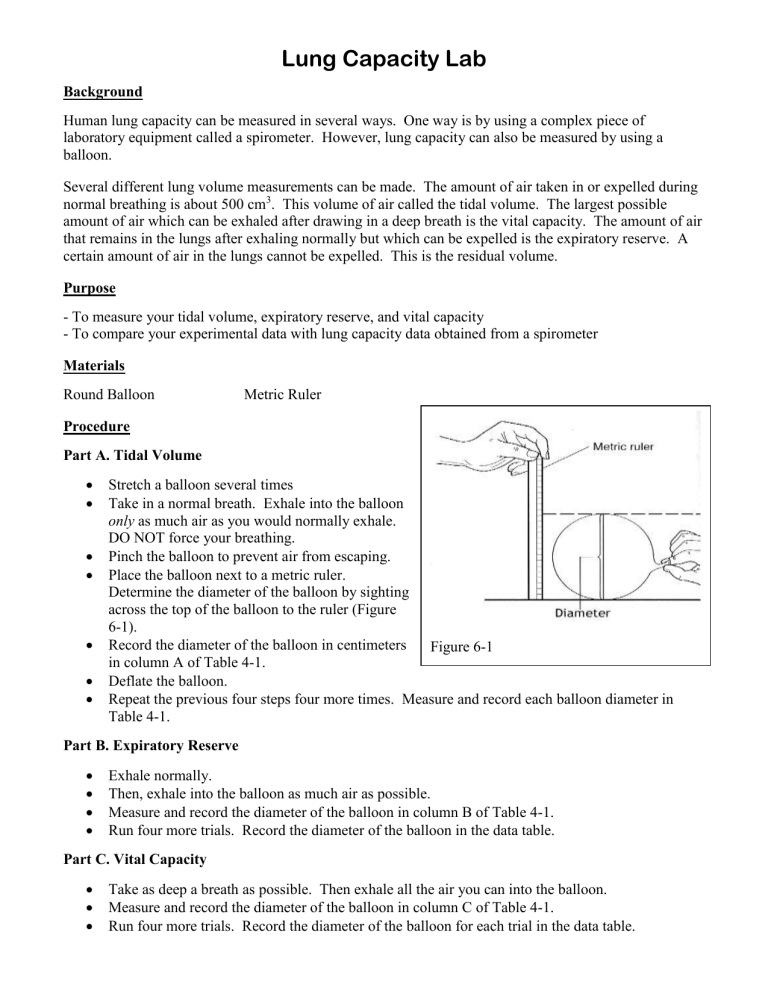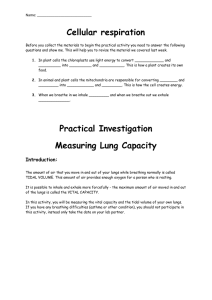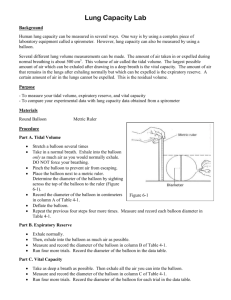Lung Capacity Lab

Lung Capacity Lab
Background
Human lung capacity can be measured in several ways. One way is by using a complex piece of laboratory equipment called a spirometer. However, lung capacity can also be measured by using a balloon.
Several different lung volume measurements can be made. The amount of air taken in or expelled during normal breathing is about 500 cm
3
. This volume of air called the tidal volume. The largest possible amount of air which can be exhaled after drawing in a deep breath is the vital capacity. The amount of air that remains in the lungs after exhaling normally but which can be expelled is the expiratory reserve. A certain amount of air in the lungs cannot be expelled. This is the residual volume.
Purpose
- To measure your tidal volume, expiratory reserve, and vital capacity
- To compare your experimental data with lung capacity data obtained from a spirometer
Materials
Round Balloon Metric Ruler
Procedure
Part A. Tidal Volume
Stretch a balloon several times
Take in a normal breath. Exhale into the balloon only as much air as you would normally exhale.
DO NOT force your breathing.
Pinch the balloon to prevent air from escaping.
Place the balloon next to a metric ruler.
Determine the diameter of the balloon by sighting across the top of the balloon to the ruler (Figure
6-1).
Record the diameter of the balloon in centimeters Figure 6-1 in column A of Table 4-1.
Deflate the balloon.
Repeat the previous four steps four more times. Measure and record each balloon diameter in
Table 4-1.
Part B. Expiratory Reserve
Exhale normally.
Then, exhale into the balloon as much air as possible.
Measure and record the diameter of the balloon in column B of Table 4-1.
Run four more trials. Record the diameter of the balloon in the data table.
Part C. Vital Capacity
Take as deep a breath as possible. Then exhale all the air you can into the balloon.
Measure and record the diameter of the balloon in column C of Table 4-1.
Run four more trials. Record the diameter of the balloon for each trial in the data table.
Part D. Conversion of Diameters to Volume
Lung volume is expressed in cubic centimeter units (cm
3
). (1,000 cm
3
is slightly more than a quart.)
To convert from balloon diameter to volume, locate the balloon diameter on the horizontal axis of
Figure 6-2. Follow this number up to the heavy line, then move across to locate the corresponding volume.
For example, if your balloon diameter is 14.5 cm, then the corresponding lung volume is
1500 cm3.
Convert each diameter for vital capacity, tidal volume, and expiratory reserve to volume.
Record the volumes in columns D, E, and F of Table 4-1.
Calculate and record your average lung volume for each of the three measurements.
Figure 6-2
Table 4-2: Average Lung Volumes
Male (cm
3
) Female (cm
3
)
Tidal Volume
Expiratory Reserve
525
1,200
475
1,000
Vital Capacity 5,000 4,000
Listed in Table 4-2 are “average” male and female lung volume measurements. The volumes were determined by using a spirometer.
Data/Results
Table 4-1
Balloon Diameter (cm)
A
Tidal
Volume
B
Expiratory
Reserve
C
Vital
Capacity
Lung Volume (cubic centimeters)
D
Tidal
Volume
E
Expiratory
Reserve
F
Vital
Capacity
Trail 1
2
3
4
5
Total
Average
Discussion:
1) Why is it important to measure tidal volume, expiratory reserve, and vital capacity five times and then get an average?
2) What is the difference between Tidal volume and Vital capacity?
3) How does your Tidal Volume compare with the average Tidal Volumes found in Table 4-2?
4) Why may there be differences between your data and the given average volumes in Table 4-2?
5) Give two (2) suggestions for improving the accuracy of your results. (How can sources of error be reduced?).
6) How might an athlete's vital capacity compare to a non-athlete? Explain your reasoning.
7) How might vital capacity be important to a musician?
Examine the data table of a person who entered into a training program. This person's vital capacity was measured over a 60 day period.
Data
Day of Training Vital Capacity
0 4800
10
20
4840
4890
30
40
50
60
4930
4980
5180
5260
8) What happened to the person's vital capacity over the course of the training period?
9) What probably caused the change?




